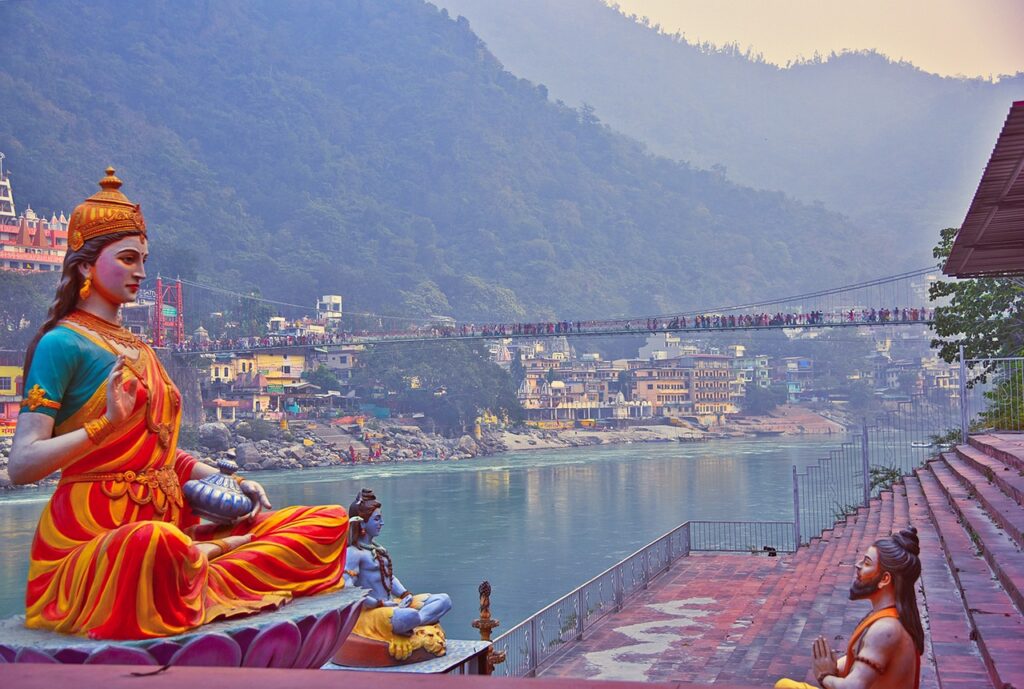
To a novice, Hinduism can appear as a religion with a multitude of deities being venerated. The extensive array of Hindu Gods and Goddesses is diverse, with each entity holding unique abilities that govern different facets of existence. This can lead to uncertainty among individuals as to whom they should venerate, and whether Hinduism adheres to a monotheistic or polytheistic belief system. The aim of this article is to provide insight and shed light on this topic by exploring the different Gods of Hinduism.
Hinduism is divided into two primary philosophical perspectives – Personal (dvaita) and Impersonal (advaita). It is important to note that some spiritual leaders perceive the Absolute as an impersonal energy, referred to as the grand luminous Brahman, and all deities are viewed as diverse forms of Brahman. Therefore, all Vedic gods are considered equal as they represent various facets of the same Brahman. In contrast, other sages believe that the Absolute is a personal, yet incomprehensible, supreme being who governs everything and is the source from which everything originates. Adi Shankaracharya is a prominent Hindu sage belonging to the Advaita (impersonalistic) school of thought. On the other hand, Madhvacharya, Ramanujacharya, Vishnuswami, Nimbarkacharya and others are notable sages of the Dvaita (personalistic) school.
The followers of the personalistic philosophy maintain that the Vedic gods are each assigned a distinct role and responsibility in managing and preserving the material world. These gods possess individual talents endowed by the Supreme Being and are tasked with specific functions on His behalf, much akin to how executives execute the commands of a company’s owner. As a result, people worship these demigods to achieve specific outcomes or advantages while leading and advancing in life. Alongside venerating the Supreme Being, and recognizing that all blessings ultimately stem from Him, one shows respect to the other demigods for their guidance in navigating this world. Listed below are some of the countless Gods and Goddesses worshiped in Hinduism.
#1 Krishna
Lord Krishna, who is considered as one of the most venerated and respected deities of all the Dharmic Gods, is explained and concluded in various Vedic texts as the Supreme Personality of Godhead. In other words, as stated in the Sanskrit language, “krsnas tu bhagavan svayam” (Srimad-Bhagavatam 1.3.28), Lord Krishna is the source of all other incarnations and forms of God. He is the ultimate and conclusive truth and goal of all philosophical inquiry, and the ultimate result of Vedanta (aham eva vedyo). In the Brahma Samhita, Lord Brahma praises Krishna as “Govindam Adi Purusham” (oldest being) and he is widely acknowledged by spiritualists in India and worldwide as the Supreme Lord (Isvara Parama Krishna).
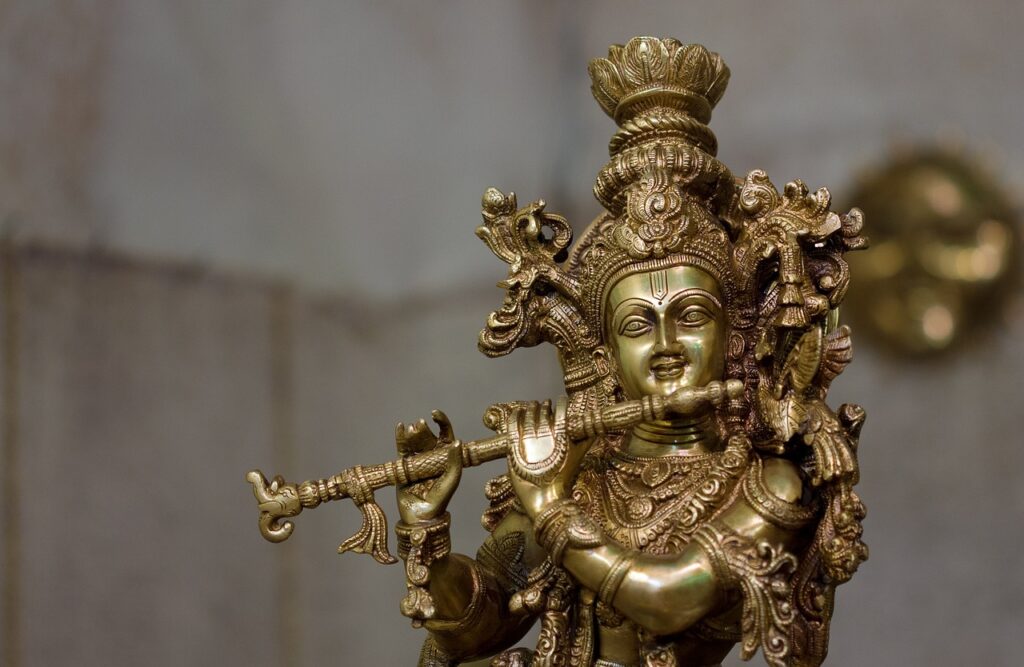
Krishna is believed to be the original and oldest personality, without any superior (anadir adir Govinda) and the ultimate cause of all causes (sarva karana karanam). In the Bhagavad Gita, Krishna reveals that he is seated in everyone’s heart as the Paramatma (Supersoul) and that remembrance, knowledge, and forgetfulness originate from him (Mattah smritir jnanam apohanam ca). He also controls the material nature (prakriti) that governs the living entities of this world (Mayadhyaksena prakrtih suyate sa caracaram).
Maha Vishnu, who lies in the causal ocean, and from whose body pores the countless material universes emanate, is considered a parial expansion of Lord Krishna. Krishna is the all-attractive personality and source of all pleasure that we continuously crave. Lord Krishna is depicted with a blue or blackish complexion and possesses a body of “sat,” “cid,” and “ananda,” the eternal form of knowledge and bliss. As a result, Krishna devotees make Him, along with His consort Srimati Radharani, their life and soul.
#2 Lord Vishnu
Lord Vishnu is one of the three divine entities in the Trimurti, known for his role as the sustainer of the universe and as a primary deity in Hinduism. He resides in Vaikuntha, the spiritual world. Lord Vishnu embodies the quality of sattva-guna, or the mode of goodness that sustains everything. He is known as Narayana, the shelter, resting place, and ultimate goal of all living beings. This sattva nature gives living beings the inclination to move towards higher truth, light, and a more intense reality. Thus, Lord Vishnu is also referred to as Hari, who eradicates the darkness of illusion. While several people regard Vishnu as the primary source of all avatars of the Lord that manifest in this world, various texts like Bhagavad-gita, Mahabharata, Bhagavata Purana, and Vishnu Purana indicate that Lord Krishna is the original source from which Vishnu emanates as an expansion.
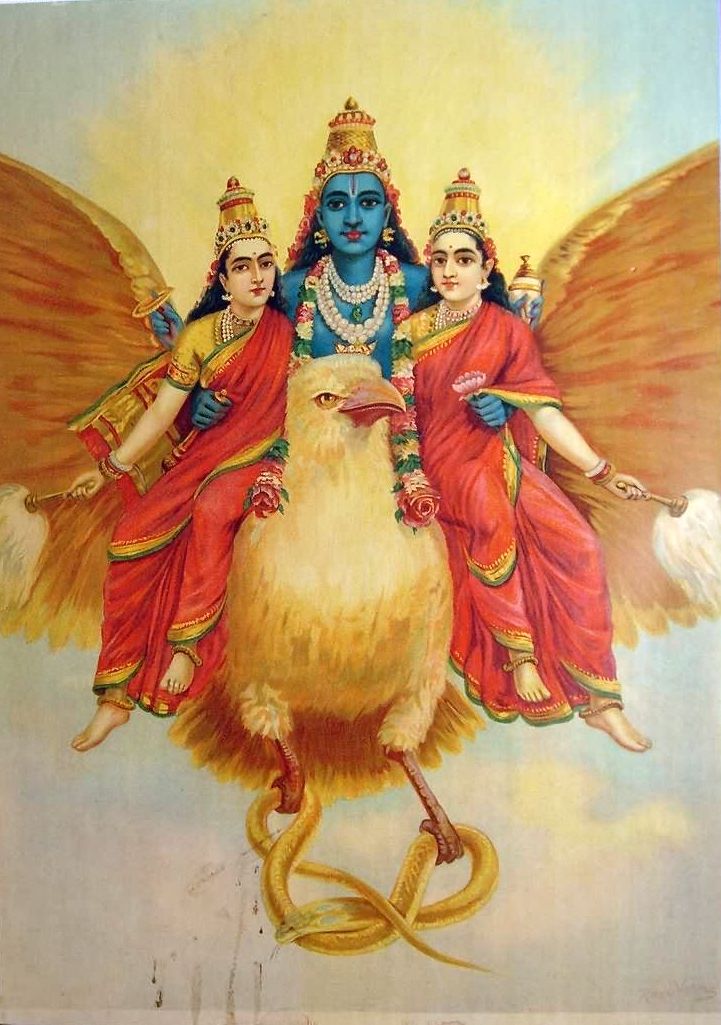
Vishnu manifests himself as Maha-Vishnu, who lies on the causal ocean and is the source of all universes. Garbhodakasayi Vishnu is an expansion of Maha Vishnu and enters each universe to create Brahma, the first living creature of the universe. Garbhodakasayi Vishnu further expands into Ksirodakasayi Vishnu, who exists in the heart of every living entity as the Supersoul. Therefore, Vishnu appears in three primary forms in the physical world: Maha Vishnu, who is the soul of the entire creation; Garbhodakshayi Vishnu, who is the soul of each universe; and Ksirodakasayi Vishnu, the antaryami, who is the soul within every living being and atom. Vishnu is often depicted as being blue in color and has four arms, each carrying a symbol. His consort is Lakshmi, and his carrier is Garuda, the giant eagle. The club and disc represent Vishnu’s enemies who violate religious and natural laws, while the lotus and conch shell symbolize joy and happiness for his devotees. The disc is known as the kala-chakra, which represents the wheel of unyielding time, with a thousand spokes.
Harir hi nirgunah saksat prakrteh parah
Sa sarva-drg upadrasta tam bhajan nirguno bhavet
(Srimad Bhagavatam 10..88.5)
–
Sri Hari (Vishnu) is beyond the modes of material nature. He is the Supreme transcendental Person. He is the all-seeing eternal witness. and is the Supreme overseer of all living entities. Whoever takes shelter at His lotus feet and worships Him attains transcendence to material nature.
#3 Lord Rama
Lord Rama, also known as Ramachandra, holds a special place in the hearts of devotees and is widely revered as one of the most popular Vedic Gods. He is known by various names such as Raghava, Rajarama, Raghupati and more, and is regarded as the 7th avatara (incarnation). The timeless epic Ramayana, which narrates the story of Lord Rama and his wife Sita, has played an integral role in shaping the Vedic culture.

As per the Bhagavata Purana, Lord Ramachandra appeared in Ayodhya, a city in northern India on the ninth day of the bright fortnight of the month of Chaitra in Treta Yuga. This day is celebrated worldwide as Ram Navami. Lord Rama was born in the dynasty of Maharaja Khatvanga, and his father was King Dasaratha, who had three wives – Kaushalya, Kaikeyi, and Sumitra. Mother Kaushalya gave birth to Lord Rama, who was none other than the Supreme Lord Vishnu, along with his full quadruple expansion. Lord Rama had three younger brothers – Lakshmana, Bharata, and Shatrughna, who were born to Sumitra and Kaikeyi.
The lineage of Lord Rama can be traced back to Maharaja Khatvanga, whose son was Dirghabahu, and his son was Raghu. King Aja was the son of Raghu, and his son was King Dasaratha, the father of Lord Rama. Lord Rama’s appearance on earth had a profound impact on the spiritual and cultural fabric of society and has been celebrated for centuries.
#4 Lord Brahma
Lord Brahma, regarded as the engineer of the universe, emerged from Lord Vishnu’s expansion known as Garbhodakasayi Vishnu, who first appears within each universe. The lotus stem sprouting from Vishnu’s navel bore Brahma, who is also known as Svyambhu, meaning self-manifested. Brahma’s four heads symbolize the four Vedas, four Yugas, and four directions. As part of the trinity of Brahma, Vishnu, and Shiva, Brahma oversees creation while Vishnu maintains it and Shiva destroys it.
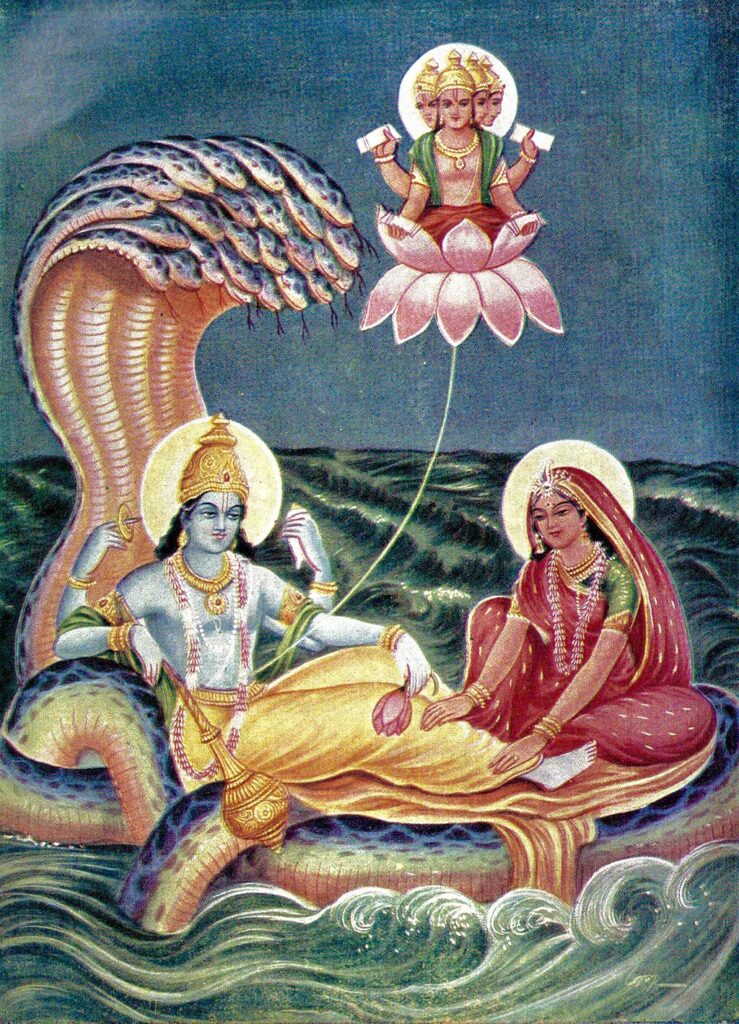
Hinduism recognizes four Yugas: Satya, Treta, Dvarapara, and Kali, and a Kalpa or a single day of Brahma consists of a thousand cycles of these Yugas. Brahma’s night is of the same duration, and during this time, the water of the causal ocean inundates all the planetary systems except the abode of Brahma and a few higher planets. When Brahma awakens at the beginning of his day, life comes into existence, and the universe becomes manifest. Brahma lives for 100 years, during which time a partial destruction occurs at the end of his day and a complete dissolution at the end of his lifetime. According to the Vedic scriptures, time varies in different planetary systems. Brahma’s lifespan is 311.04 trillion human years, which is also the destined lifespan of this universe.
#5 Lord Shiva
Lord Shiva is a prominent deity in Hinduism who is described as a peaceful personality and considered the greatest among all demigods. He is also regarded as the best devotee. He has his own spiritual line or sampradaya called the Rudra-sampradaya. Shiva controls the material energy and is often accompanied by his dangerous energies, goddess Kali or goddess Durga.
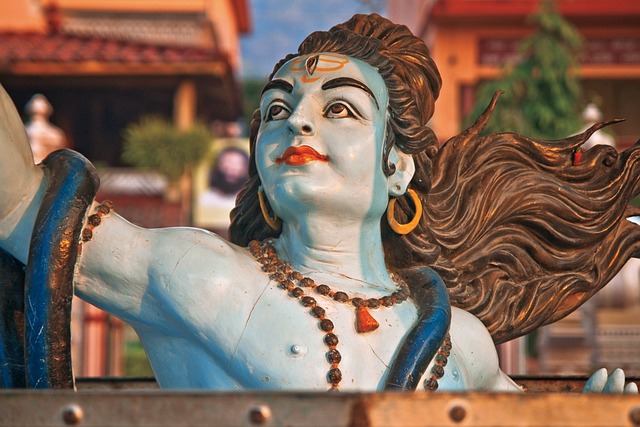
Shiva is depicted as a handsome young man with long hair, a crescent moon, and usually with four arms holding a Trishula and a Damaru. Mount Kailash is considered his abode, and he is often worshiped with his consort Shakti, also known as Parvati. The dual worship of Shiva-Shakti is the subject of an entire theology, and many tantric traditions are associated with it. Shiva’s carrier is Nandi, the bull, who often appears in temples facing his lord. Maha Shiva Ratri is the main festival associated with Shiva, celebrating his marriage to Parvati. Shiva has many names, including Mahadeva, Pashupati, Nataraja, Vishwanath, and Bhole Nath. He is often depicted as a phallic symbol called the Shiva Lingam when he is not represented in his blue-skinned human form.
#6 Lord Ganesh
Ganesh (also spelt as Ganesha) is a Hindu deity who is worshiped as the Lord of thresholds and entrances. He is often seen above them or at temple gates, to remove obstacles and provide blessings. He is the son of Shiva and Parvati and is recognized as the Lord of astrology and author of scriptures. Ganesh has two wives, Siddhi, meaning success, and Riddhi, meaning prosperity. His elephant head was acquired after losing a battle with his father, Shiva, and having his original head removed. Shiva revived him by attaching an elephant’s head to his body. He usually rides a mouse, who aids him in overcoming obstacles to success. Ganesh has numerous names, such as Ganesh, Vinayaka, Vighneshvara, Gajanana, Gajadhipa, and Jyeshtha-raja. The primary texts dedicated to Ganesh include the Ganesha Purana, the Mudgala Purana, and the Ganapati Atharvashirsa, along with the Brahma Purana and Brahmanda Purana.
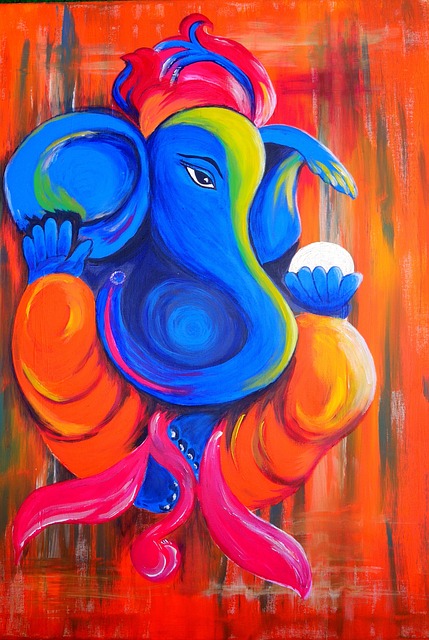
After winning a competition against his brother Kartikaya, Ganesh became the Lord (Isha) of all existing beings (Ganas). In this contest, Ganesha was required to race around the universe, but he chose to circle his parents, Shiva and Parvati, whom he believed to be the source of all existence. This demonstrated his intelligence.
Ganesh is often portrayed with particular symbols, as described in the Ganapati Upanishad (11-14). He is typically depicted with one tusk and four hands, with two hands holding a noose and a hook. The noose signifies the ability to liberate oneself from delusion and attachment leading to anger, while the hook motivates one towards their goal. Ganesh’s other two hands offer blessings and assurance of fearlessness, often holding a rice ball representing the reward of spiritual practice. He has a big stomach and large ears, indicating that he accepts truthful and virtuous vibrations while rejecting false and non-virtuous words. Ganesh is often adorned with red vermillion, symbolizing his intense work ethic and association with action. He has a strong appetite and is often offered sweets and delicacies.
#7 Hanuman
Hanuman, a Hindu deity widely venerated in India, is often portrayed as a monkey-like figure who kneels before Rama, Sita, and Lakshmana, and tears open his chest to reveal an image of Rama in his heart. As the son of Vayu, the wind god, Hanuman possesses superhuman abilities that he employs for good and in the service of Lord Rama and Sita.
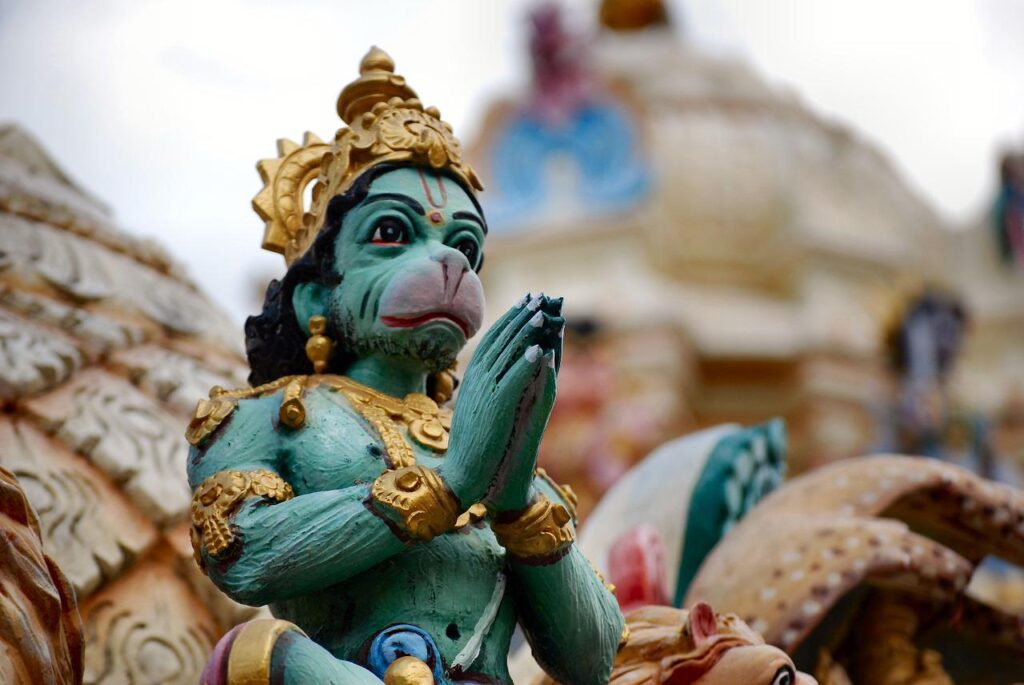
In addition to his strength and courage, Hanuman is renowned for his wisdom and devotion. Although he is worshiped by Vaishnava groups who venerate Krishna and his avatars, Hanuman is also revered by wrestlers and adherents of other faiths. While some regard Hanuman as an autonomous deity, it is established in the scriptures that he is a devotee of Rama. Valmiki’s Ramayana chronicles Hanuman’s birth, upbringing, and the extraordinary gifts he receives. While Hanuman exhibits simian traits, they are considered divine arrangements for his devotion to Rama. Throughout the Ramayana, Hanuman displays unwavering devotion to Rama, which is regarded as his greatest attribute. He is also known as Maruti and Anjaneya, named after his mother, Anjana. Devotees seek Hanuman’s blessings for enhanced devotion to Lord Rama.
#8 Goddess Lakshmi
Lakshmi, the eternal companion of Lord Vishnu, is frequently worshiped with him as Lakshmi-Narayana, but also venerated separately, particularly during Diwali. Often depicted seated or standing on a lotus, she carries a lotus and water pot in two hands, while showering coins and offering benedictions with the others. She is clothed in a pink sari, surrounded by auspicious symbols, including elephants spraying water from their trunks. Lakshmi is also known as “Shri,” meaning beautiful, and “Chanchala,” meaning fickle, symbolizing the unpredictable nature of worldly fortune. Nevertheless, she never forsakes her consort, Lord Vishnu.
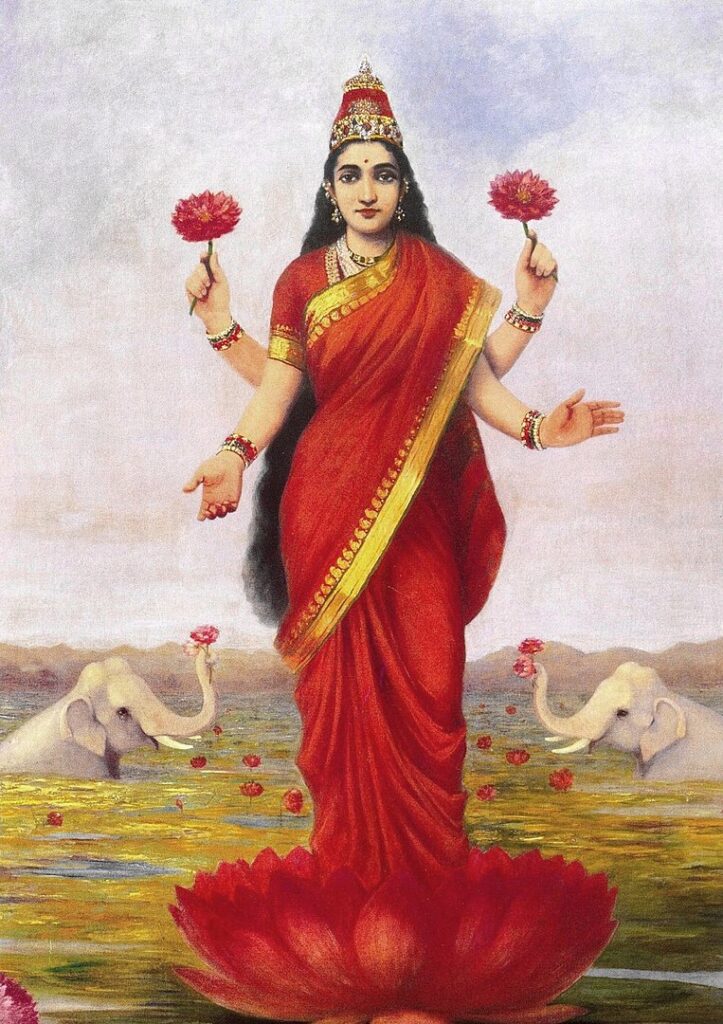
Although she is considered Vishnu’s eternal consort, she appeared from the ocean of milk during the churning of the gods and demons, helping the gods regain their fortune in their battle against the demons. In each of Vishnu’s appearances, such as Vamana, Parashurama, Rama, or Krishna, Lakshmi appeared as Padma or Kamala, Dharani, Sita, and Rukmini, respectively. She is thought to reside on Vishnu’s chest, earning him the name Shrinivas. In South India, particularly at Tirupati, she is known as Padmavati, the consort of Vishnu in the form of Venkateshwara.
#9 Goddess Durga
Durga, the Goddess of the universe, is also known as Parvati, the wife of Lord Shiva. She represents knowledge, wisdom, and memory and has up to 64 forms, each with a unique name and representing different aspects of the Goddess. Each form represents a different pastime, power, or aspect of the Goddess. Some of the names of these forms of Durga include Amba or Ambika, Bhadra, Bhadrakali, Aryadurga, Vedagarbha, Kshemakshemakari, Naikabahu, Bhagavati, Katyayani, Meenakshi, Rajarajeshvari, Kali, Devi, and others, such as Sati, which means chastity. Thus, these are all different aspects of the same goddess. Durga is often depicted as a beautiful woman in red cloth with multiple arms, holding various items that represent her powers.
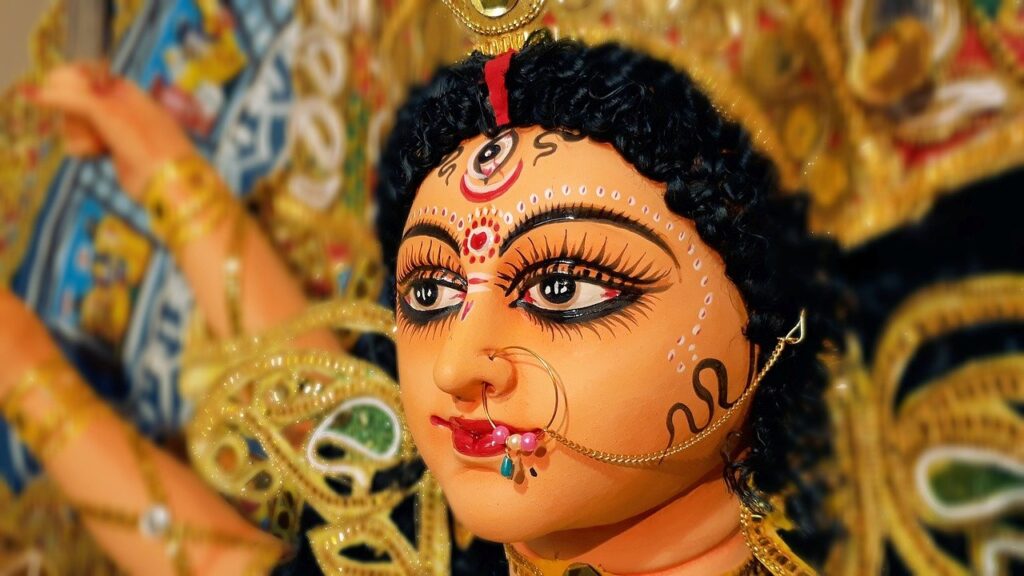
Durga Puja is an annual Hindu festival celebrated in South Asia in honor of the Goddess. The festival celebrates the victory of good over evil and the power of the Goddess to fight against demonic forces. During the festival, devotees offer prayers, perform rituals, and make offerings to the Goddess to ensure peace, prosperity, and religion.
#10 Goddess Saraswati
Saraswati, worshiped as the goddess of learning, intelligence, arts, and skills, is revered as the bestower of essential knowledge of the self. She is Brahma’s consort and is regarded as the mother of knowledge. With many forms and names, including Vach and Vedamata, Saraswati symbolizes speech and is known as the mother of the Vedas. Additionally, she is recognized by the names Shatarupa, denoting the goddess of material existence, and Bharati, signifying eloquence.
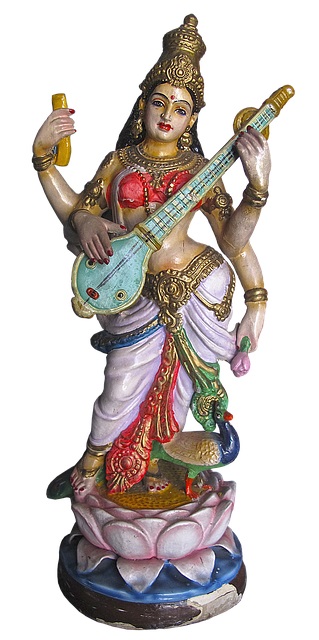
Together, Brahma and Saraswati gave birth to Manu, the father of humanity and author of the Manu Smriti. Saraswati’s color, white, signifies purity, while her vehicle is either the swan, goose, or peacock. The primary festival dedicated to Saraswati is Saraswati Puja, which is observed during Vasant Panchami, and she is also worshiped during Navratri.